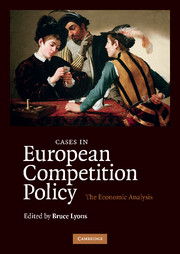Book contents
- Frontmatter
- Contents
- Contents by potentially anticompetitive business practices
- Contents by markets
- List of figures
- List of tables
- List of contributors
- Preface
- Introduction: the transformation of competition policy in Europe
- A Anticompetitive behaviour by firms with market power
- B Agreements between firms
- C Mergers
- Introduction
- C.1 Measurement of unilateral effects
- C.2 Coordinated effects
- 14 The ups and downs of the doctrine of collective dominance: using game theory for merger policy
- 15 Capacity constraints and irreversible investments: defending against collective dominance in UPM Kymmene/Norske Skog/Haindl
- C.3 Vertical and conglomerate effects
- Bibliography
- Index
14 - The ups and downs of the doctrine of collective dominance: using game theory for merger policy
Published online by Cambridge University Press: 05 June 2012
- Frontmatter
- Contents
- Contents by potentially anticompetitive business practices
- Contents by markets
- List of figures
- List of tables
- List of contributors
- Preface
- Introduction: the transformation of competition policy in Europe
- A Anticompetitive behaviour by firms with market power
- B Agreements between firms
- C Mergers
- Introduction
- C.1 Measurement of unilateral effects
- C.2 Coordinated effects
- 14 The ups and downs of the doctrine of collective dominance: using game theory for merger policy
- 15 Capacity constraints and irreversible investments: defending against collective dominance in UPM Kymmene/Norske Skog/Haindl
- C.3 Vertical and conglomerate effects
- Bibliography
- Index
Summary
Introduction
Merger control has been an explicit responsibility of the European Union since 1990. During that time there has been a significant evolution in the way mergers are analysed, as well as in the institutional setting within which merger control is implemented. This chapter looks at just one aspect of this complex evolution – the development of a doctrine of collective dominance making use of game theory. The economic phenomenon of market power had to be cast until recently under the notion of a dominant firm. In ordinary English language there can be only one ‘dominant’ individual in any group, so only one dominant firm in any market. But there can be market power when several firms are powerful even if none of them is dominant. Accordingly, European competition law had to stretch the concept of dominance to accommodate the concept of market power, by the ingenious invention of the idea that firms can be dominant collectively. This may sound a bit like the notions of group monogamy, or democratic centralism, but it has a logic that we shall examine in more detail below.
Until Airtours, collective dominance was not associated with any particular type of oligopolistic interaction that might lead to the exercise of market power when none of the firms can be seen as individually dominant. Yet strategic interactions among the few are a pervasive phenomenon in modern economies, which most of the time has no anticompetitive implications at all.
- Type
- Chapter
- Information
- Cases in European Competition PolicyThe Economic Analysis, pp. 349 - 382Publisher: Cambridge University PressPrint publication year: 2009
- 1
- Cited by



